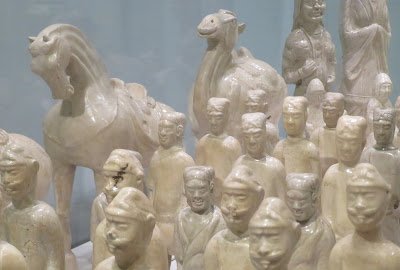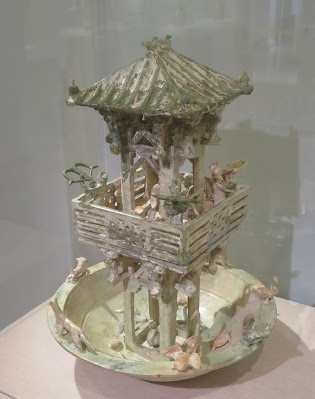On the ground floor just off of the lobby are a series of galleries and a wide hallway dedicated to the range of ethnographic objects arranged by broad regions and cultural topics like Oceania, East Asia, Africa, Islam, Indian sub-continent. Today I made time at the start of my visit to explore the two galleries filled with East Asian art of China, Korea and Japan.
Water-Moon Guanyin, 15th century, Ming Dynasty (1336-1644 CE)
The story of Guanyin is that she was a disciple of the Buddha Amitabha and through his teachings attained enlightenment, but chose not to enter into the state of nirvana. Instead she remained among the living to relieve the suffering of other creatures. She was able to assume many forms. The Water-Moon Guanyin is one where she often sits at the edge of a pond or stream at night contemplating the ephemeral nature of the moon's reflection on the water. This sculpture is bronze, though originally was gilded with gold.
Mortuary Retinue, late 6th-early 7th century,
Sui (581-618 CE) or Tang (618-907 CE) Dynasty
Soul Urn Decorated with Seated Buddha Figures, late 3rd century
Western Jin Dynasty (265-317 CE)
Gandharan Head of Buddha, 4th-5th century
probably Hadda, Afghanistan
With the exact provenance uncertain, this is still utterly remarkable. It's at least, 1,500 year old, and it's not made of marble or granite, or even sandstone--it's stucco! Think plaster.
Three works: Birds in a Coop, Dog in a Yard, and Pig in a Pen, 4th Century
Eastern Jin Dynasty (317-420)
These items were all created to be included in tombs of the wealthy. And while they may represent farm and domestic animals that would bring the departed comfort and prosperity, they are may have been symbols representing the year of the deceased's birth from the zodiac years of the: Rooster, Dog and Pig.
Tower Surrounded by a Moat, 1st-2nd century
Eastern Han Dynasty (25-220 CE)
What an exquisite piece for being nearly 2,000 years old! The details and care it must have taken to fire it in a kiln. More than a festive outing of an Emperor or Lord with his hunting party, this object is rife with hidden symbolism. China 中国 (Zhong - Guo) is a combination of the symbols for "Middle" and "Land," the place the people of China have believe they hold within the larger scheme of the world. The structure represents a mountain that rises out of water. The humans reside on a platform; higher than the natural world below, but lower than the tile roof with it's doves representing the heavens. The archers stand ready at the four corners (East, West, North and South) to defend their lord.
One of the archers.
Dogs chase rabbits and geese around the rim of the bowl, while figures of swans, cranes and fish inhabit the now dry basin.
Sake Bottle, 19th century,
Possibly Niigata Prefecture, Japan
I was captivated by the whimsical image of the sailing ship and ocean waves.
Glass Bowl, 2004
Do Ho Suh, 1962 - (South Korean)
I think this was the most contemporary of the pieces in these galleries. I don't know how well the image depicts the bottom of the bowl. The rough area is the imprint of two human hands pressed together in the manner of the State Farm insurance logo.














No comments:
Post a Comment